
|
The Society of Folk Dance Historians (SFDH) Israel and Early Israeli Dance By Don Buskirk
YouTubes illustrating or amplifying the topic discussed are
[
Home |
About |
Encyclopedia | CLICK AN IMAGE TO ENLARGE |

|
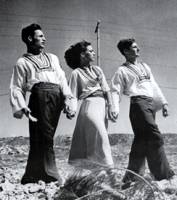 The dances of Israel have long been favourites among Recreational Folk Dance enthusiasts. Yet, like the state of Israel itself, Israeli dances have, from their beginnings, been enveloped in controversy. In many ways, the history of Israeli dance parallels the history of Israel itself.
The dances of Israel have long been favourites among Recreational Folk Dance enthusiasts. Yet, like the state of Israel itself, Israeli dances have, from their beginnings, been enveloped in controversy. In many ways, the history of Israeli dance parallels the history of Israel itself.
We all know that thousands of years ago Jews carved a homeland out of the territory East of the Mediterranean Sea, roughly between the modern states of Egypt, Syria, Palestine, Lebanon, and Jordan. Jews were not the only people living there: their autonomy and independence were often short-lived; borders fluctuated widely. During Jesus' lifetime, the land known as Judea was a troublesome client state of the Roman Empire. Frequent revolts eventually led to the massacre of Jews and, in 131, expulsion from Jerusalem. As Jews settled throughout the known world, contact with local populations and isolation from a homeland eventually resulted in the formation of three more or less distinct groups.
1. Mizrahi (Hebrew for "Eastern") Jews stayed fairly close to home, spoke a Hebrew-infused form of Arabic, Aramaic, or Persian, and by-and-large accommodated themselves peacefully in the Islamic world that overtook them.
2. Sephardim (Hebrew for the "Iberian peninsula") established a highly cultured and successful presence in Moorish Spain and Portugal, transferring Greco-Roman learning to European neighbors. They spoke an early version of Spanish, with borrowings from Turkish, Hebrew, Greek, Arabic and French (known as Ladino). When Christians reconquered Iberia in 1492, some persecuted Jews fled to tolerant parts of Europe and South America, but most stayed within the more tolerant Ottoman Empire, resettling in North Africa, the Balkans, and Middle East.
3. Ashkenazi (from "Ashkenaz," a biblical kingdom of the far north). By about 1000 CE Jewish scholars used "Ashkenaz" to refer to the Germanic lands, and as they began to populate the area, to the Jews of central and eastern Europe. The language of the Ashkenazi is Yiddish, based on High German, blended with Hebrew and Aramaic. About 90% of North American Jews are Ashkenazim, as are a little under half of Israeli Jews.
By the late 1800's, millions of Jews were scattered around the world, living under vastly differing circumstances, and becoming increasingly aware of each others' issues. Half the world's Jews lived in the Russian empire (which included present-day Poland and surrounding lands) and were suffering intense persecution. Jews in Europe and America (Ashkenazim and some Sephardim) were becoming prosperous, highly educated, and politically influential. Jews in the crumbling Ottoman Empire (Sephardim and Mizrahi) were not-too-badly treated and relatively content.
Aliyah – Moving to Israel
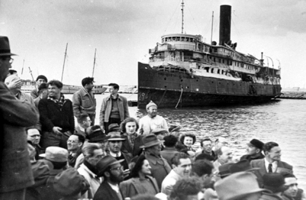 It was primarily the plight of Russian Jews (Ashkenazim, as portrayed in "Fiddler on the Roof") that inspired the Europeans and Americans to strive to create a Jewish national homeland (Zionism), and it was primarily European and American Jews (Ahskenazim) who supported the cause. They began financing groups of Russian refugees to emigrate to Jerusalem and its environs, at first with the co-operation of local authorities. From 1882-1948, Jews immigrated in six waves (called by Israelis "Aliyah"), each with it's own ethnic mix, and political and religious ‘personality'.
It was primarily the plight of Russian Jews (Ashkenazim, as portrayed in "Fiddler on the Roof") that inspired the Europeans and Americans to strive to create a Jewish national homeland (Zionism), and it was primarily European and American Jews (Ahskenazim) who supported the cause. They began financing groups of Russian refugees to emigrate to Jerusalem and its environs, at first with the co-operation of local authorities. From 1882-1948, Jews immigrated in six waves (called by Israelis "Aliyah"), each with it's own ethnic mix, and political and religious ‘personality'.
1st Aliyah, 1882-1903. 35,000 Jews, mostly from the Russian Empire (not necessarily Russian). Mostly pious Jews, who just want to live and die in the Holy Land. At this point Jews comprised about 7% of the population of Palestine.
2nd Aliyah, 1904-1914. 40,000, mostly from Russia. Socialist-influenced, established the first Kibbutz, self-defense organizations, political parties. Hebrew became the spoken language (replacing Mizrahi, Yiddish). The first newspapers and literature were published in Hebrew.
Upon the collapse of the Ottoman empire in 1918, Britain gained control of what it termed "Palestine," and allowed many more Jews (mostly Ashkenazim) to immigrate. Unlike earlier pious Jews these Jews had just escaped the Bolshevik Revolution and were highly politicized (Remember the young revolutionary in Fiddler on the Roof?). Many were Socialists, some openly Atheists who wanted to improve on the Soviet model. Many had formal agricultural training, and wanted to "make the desert bloom." Their ideology was fuelled by Western European ideas of the corruption of industrial society and a return to the purity of agricultural life. Palestine became a proving ground for social experiments.
3rd Aliyah, 1919-1923. 40,000, mainly from Eastern Europe. Ideologically driven, trained agriculturalists. Started an elected assembly, labour federation, Haganah (forerunner of Israeli Defence Forces).
Beginnings of Israeli Dance
Israeli dances at this time were non-existent. Dancing consisted of the dances the immigrants brought with them. From Eastern Europe; Bulgar, Freylach, Hora, plus, Alexandrova from Russia, Krakoviak and Mazurka from Poland, Polka and Sher from Central Europe, and many others. In addition, some Jews evolved dance moves from the local Circassians into Cherkessia Kfula, and learned the native Palestinian dance Dabke.
1924 – First Israeli Dance – Hora Agadati
4th Aliyah, 1924-1929. 82,000 from Poland and Hungary (fleeing anti-Semitism). Middle class, urban, established small business, light industry. By now Jews comprise 15% of the population of Palestine.
Kibbutz – the Soul of Israeli Dance
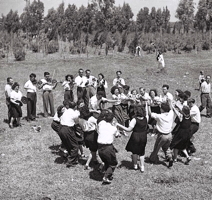
It was from the heady stew of ideologies and the hopes for a rebirth of Judaism that the Kibbutz movement was born. Within the movement there was a wide variety of goals and types of organization, but most were egalitarian, self-contained, self-supporting agricultural communities – what we in the 1960's would call communes. The kibbutzniks were self-consciously creating a new way of living, and that called for a new way of dancing. They wanted their dances to reflect optimism, energy, equality, the agricultural cycle, appreciation of nature, and connection to past spiritual values – all ideas rooted in Western European thought. Their dance influences were Isadora Duncan, Martha Graham, ballet and modern dance, as well as the folk dances of their native Poland, Romania and Russia. In the 1920's and 30's kibbutz meetings began with dancing around a campfire. Many of these dances were the fresh creations of kibbutzniks.
By the 1940's Kibbutz's were numerous enough to be aware of their growing influence on the culture of Palestine. They were sharing ideas (and dances), becoming prosperous and expansive – enough to arouse Arab jealousy, fear, suspicion, and resentment. The British administration, attempting to appease the majority Arab population, were not very supportive. Kibbutz's were becoming armed camps. It was in this hostile environment that Gurit Kadman decided in 1944 to organize the first Israeli dance festival, at Kibbutz Dalia. Travel was restricted and dangerous, yet the two-day festival was a huge success – bringing together for the first time the young movers and shakers of Israeli dance – an Israeli Woodstock (though on a much-smaller scale).
Mayim, Mayim – one of the first (1937) still-popular dances to emerge from this environment, is a perfect example of this new style – a celebration of the discovery of water (nature) on a kibbutz (socialism, agriculture) after a seven-year search (optimism), with vigorous music (energy), a circle, non-partner formation (equality), and text from Isaiah (spiritual, tradition).
5th Aliyah, 1929-1939. 250,000, from Poland, Germany, Austria, Czechoslovakia, Greece, and a few from Yemen. Jewish population 28% of total. Many were professionals – doctors, lawyers, professors, musicians. Haifa developed into a port with oil refineries. Palestine was becoming developed beyond native Palestinians' recognition.
In 1935 the approximate makeup of Palestine's population: 27% Jewish, 64% Moslem, 8% Christian (Armenians, Copts, Greek Orthodox, Assyrians, European Christians), 1% Other (mostly Druze).
The influx of Ashkenazim peoples and ideas into an Islamic, primarily Arab country, with a minority of Sephardic, Mizrahi, Christian, and dissenting Arab cultures, was not without problems. Some idealistic Ashkenazim envisioned Israel becoming a multicultural state, while others wanted a return to a conservative one-dimensional Judaic theocracy. Arabs were becoming increasingly hostile as they watched their land being gobbled up and their control eroded. Arabs rioted against Jews. The British banned further immigration just when Hitler's anti-Semitic agenda was becoming apparent.
Within the Jewish community there were divisions along Ashkenazic/Sephardic/Mizrahic lines, not only of the political vision, but of the cultural vision and image of Israel. Ashkenazim were caught up in their vision of progress, and had little appreciation of the more conservative (and oriental) Sephardic and Mizrahic traditions. Sephardim and Mizrahim resented becoming marginalized in their own land.
Aliyah Bet, 1933-1948. 110,000 smuggled in, mostly Holocaust survivors. Palestine was 33% Jewish. Jewish sentiment turned against British rule. Resistance groups formed and grew powerful.
The Israeli dance creation machine began kicking into high gear in the late 1940's. Most of the early choreographers were Ashkenazi kibbutzniks who made some effort to include elements of other Jewish and even non-Jewish cultures into their dances, but the results were decidedly European-looking and sounding.
Early Creators and Creations
- Zevi Idelson – Hava Nagila (Song), 1918
- Baruch Agadati – Hora Agadati, 1924
- Elsie Dublin – Mayim, 1937
- Sarah Levi-Tanai – Kol Dodi, (double lines) 1944
- Leah Bergstein – Shibboleth Bassadeh, 1945 – Rav Brachot, 1958
- Schmues "Vicki" Cohen – Hora Mamtera, 1953
- Raya Spivak – Ma Navu, 1956
- Yo'av Ashriel – Erev Ba, 1960; Hora Medura, 1963
- Danny Uziel – At Va-ani, 1962; Mechol Halalat, 1963
RIVKA STURMAN
Born 1900 in Poland, raised in Leipzig, Berlin, studied modern dance, moved to Palestine in 1929. Choreographies include:
- 1945 Harmonica, Kuma Echa
- 1947 Debka Gilboa
- 1948 Zemer Atik, Kol Dodi, 1946 or 48
- 1950 Hashual, Hineh Ma Tov
- 1953 Ahavat Hassadah
- 1953 or 1956 Ve David
- 1964 Machar
- First Yiddish (Zemer Atik), Yemenite (Hineh Ma Tov)
Sephardic, Mizrahi Aliyah
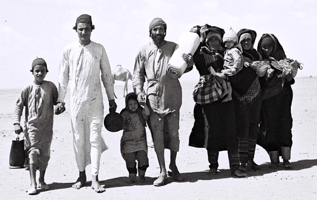 In 1948, the British withdrew from Palestine, leaving Jews and Arabs to fight over territory. The Arab world, feeling betrayed by British and American support for Jewish expansionism, retaliated not only by attacking Israel, but also by expelling or persecuting Jews in their home countries. The barely solvent new state of Israel decided to rescue as many refugees as possible, airlifting hundreds of thousands of Mizrahim and Sephardim.
In 1948, the British withdrew from Palestine, leaving Jews and Arabs to fight over territory. The Arab world, feeling betrayed by British and American support for Jewish expansionism, retaliated not only by attacking Israel, but also by expelling or persecuting Jews in their home countries. The barely solvent new state of Israel decided to rescue as many refugees as possible, airlifting hundreds of thousands of Mizrahim and Sephardim.
- 1948-53 – 50,000 Yemenite Jews, 122,000 Iraqi Kurdish Jews, 34,000 Tunisians, 31,000 Libyans, 20,000 Moroccans, 19,000 Egyptians, 35,000 Turkish, 30,000 Iranians, 3,000 Indians, 2,500 Chinese
- TOTAL 1948-53 – 355,000 Sephardic, Mizrahi
- (TOTAL 1948-53 – 340,000 Europeans)
- 1979 – 30,000 Iranian Jews
- 1984, 1991 -30,000 Ethiopian Jews
Suddenly the balance of immigration shifted from mostly Ashkenazim to mostly Shephardim and Mizrahim and with it, Israeli culture took on a more Middle Eastern tone. Modern, Europeanized Jews came face-to-face with Jews from Yemen – a culture that had changed little in thousands of years. Jews were seeing living echoes of their ancient past.
Israeli dance choreographers began to add Mizrahi elements into more dances, and a figure from Yemeni dance, now known as the Yemenite step, became a core feature of Israeli dances. Ma Navu, choreographed in 1956, is an excellent example;
But it wasn't until the arrival on the scene of Moshiko Halevy in the 1970's that Israeli dance had a choreographer whose creations seemed more at home in Palestine than Vienna. Ya Abud is more Dabke than Hora.
Seeing Israeli and Jewish Dance
A wonderful anthology of writings on the history, variety, and important personalities of Israeli Dance, profusely illustrated, is Seeing Israeli and Jewish Dance edited by Judith Brin Ingber. Wayne State University Press, ©2011.
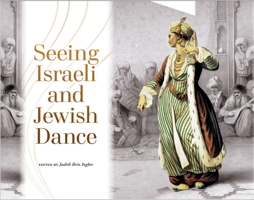
From Don Buskirk's website, Folkdance Footnotes.
Used with permission.
This page © 2023 by Ron Houston.
Please do not copy any part of this page without including this copyright notice.
Please do not copy small portions out of context.
Please do not copy large portions without permission from Ron Houston.